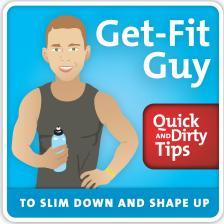Barefoot Running: Is it Safe?
In Part 1 of this special two-part episode, Get-Fit Guy discusses the safety concerns surrounding barefoot running as well as the recent Vibram lawsuit related to potentially dangerous minimalist running shoes.

I have a confession to make. I am very, very uncomfortable when I am standing around at a party or social gathering wearing shoes. I don’t like shoes. As a matter of fact, I avoid shoes (and sometimes pants, too) when I’m working at home. I am that guy who sits around writing and recording podcasts in my boxers.
In the episode The 411 on Barefoot Running, you learned about the growing surge in the popularity of barefoot running, the biomechanics of running, running with shoes vs. running barefoot, and how to make a gradual transition to barefoot running.
In this special two-part episode, you’re going to learn whether barefoot running is safe, if barefoot running is better than running in shoes, what I think about the recent Vibram lawsuit, and whether kids should run barefoot.
The Latest Research on Barefoot Running
A recent article piqued my attention and inspired me to revisit this controversial topic. The article “Barefoot Running Survey: Evidence from the Field” delves into the fact that a growing group of runners are making the choice to try the minimal or barefoot running styles of the pre-modern running shoe era (that is, running like a caveman would).
And while there is some evidence of decreased impact forces and rotational torques on the foot, ankle and knee when you do barefoot running, the survey highlights the fact that there is no clear data regarding how this actually corresponds with injuries in the real world, or what science calls “the field”.
So this survey looked into factors related to performance and injury in runners who have tried barefoot running by doing a 10-question survey on barefoot running, which 509 participants responded to.
So what were the results? The majority of the participants (53%) saw barefoot running as a training tool that could improve their running. Close to half (46%) saw training barefoot as a viable alternative to shoes. A large portion of the runners had initially tried barefoot running due to the potential for improved efficiency, an attempt to get past an injury and of course, the media hype around barefoot running.
Amazingly, 68% of the runners in the study had no new injuries after starting barefoot running.
Amazingly, 68% of the runners in the study had no new injuries after starting barefoot running, and even more amazingly, the majority of runners actually experienced a decrease in symptoms of their previous knee, foot, ankle, hip, and low back injuries after starting barefoot running. Ultimately, the results show that a large percentage of this sample of runners experienced benefits or no serious harm from transitioning to barefoot running.
And of course, it’s very, very important to mention that by “barefoot running” the survey is referring not to just running around completely unshod, but also the use of shoes such as Vibram Five Fingers, Nike Frees, Nike Flex, Merrell Trail Gloves, Vivo Barefoot, Skora Forms, or maybe just that old pair of wool socks you don’t have a use for anymore.
What About the Vibram Lawsuit?

Vibram has actually agreed to pay $3.75 million to settle a group of lawsuits accusing the company of false advertising, specifically the claims that its shoes could strengthen foot muscles while reducing running injuries.
In the settlement, Vibram must pay each customer (over 70 million of them!) a partial refund of $94 on their shoe purchase, and will no longer be able to make those claims in future advertising.
I personally think the whole lawsuit was quite silly, because it placed the blame on Vibram without acknowledging that most people who started barefoot running and didn’t follow the type of advice I outline in my previous episode on this topic showed a complete lack of common sense and logged tons of new miles in their new shoes while expecting their feet – used to overprotected, stabilizing footwear – to simply handle the abuse.
As this excellent article on SportsScientists.com points out:
“I wonder, for instance, how Vibram is different to say, that deodorant company that promises me that a quick spray before work will have a horde of beautiful women chasing me down the street? Or whether drinking that sports drink will really give me never-felt-before powers of endurance that would make Lance Armstrong blush?”

In the meantime, do you have more questions or comments about barefoot running? Leave your thoughts over at Facebook.com/GetFitGuy.






